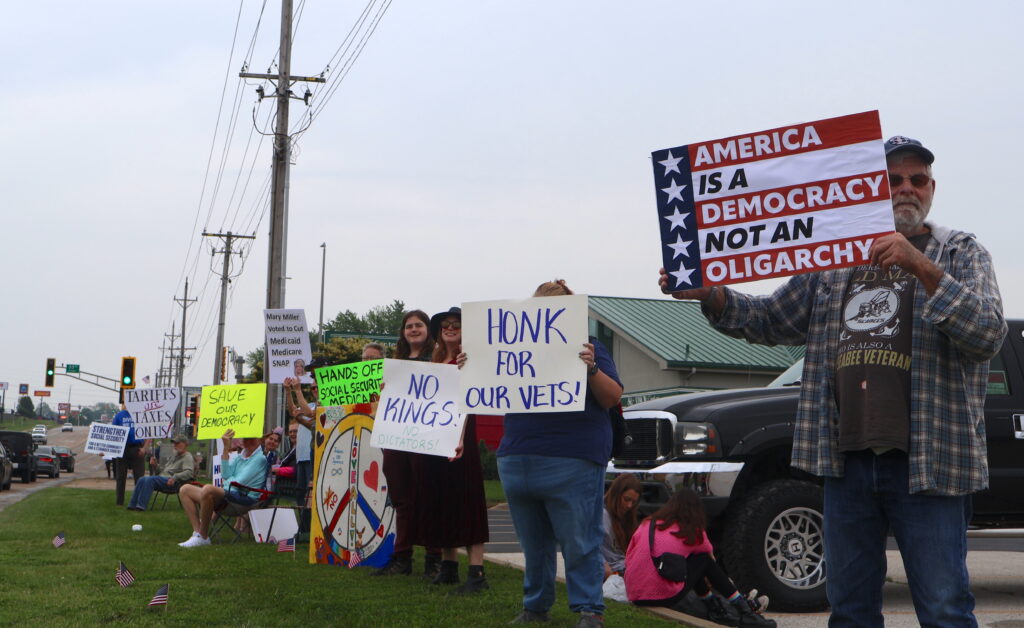‘I stood up straighter when I was in my military uniform’: Quincyans protest federal cuts impacting veterans

QUINCY — Angel Smith grew up during the Cold War, a time when the world held its breath as the United States and the Soviet Union engaged in a passive-aggressive nuclear-armed headwrestle for global political, economic and ideological influence. The fall of the Soviet Union in 1991 marked the end of the war, and the following year, Smith enlisted in the U.S. Navy.
She served as a Russian translator for 12 years and monitored live Russian naval communications for any sign of threat against the United States — a position requiring the nation’s highest level of security clearance due to its access to the government’s most sensitive intelligence information.
“I had a real sense of purpose, like I was doing something very worthwhile for the United States,” she said. “I even had a co-worker comment one time that I stood up straighter when I was in my military uniform.”
Smith was one of several attendees at a protest held Saturday morning in front of the office of U.S. Congresswoman Mary Miller (R-15) in solidarity with the nationwide group 50501 Vets, a “non-partisan coalition of veterans committed to strategizing, mobilizing and taking action on critical issues affecting our community and beyond,” and vets across the nation in protesting federal funding and personnel cuts that impact veterans.

Tim Boivin, an Illinois-born U.S. Army veteran who served from 1979 to 1988, said he came out of retirement to advocate for veterans’ healthcare. Now based in New England, Boivin is a spokesperson for the non-profit political action group American Opposition and 50501 Vets.
“The current administration is cutting benefits for veterans on everything from healthcare to housing. That cannot stand,” he said in a phone interview with Muddy River News on Saturday. “Anybody, regardless of party, who thinks that this is OK is betraying our veterans.”
Roughly 6.7 million veterans benefited last year from healthcare, education opportunities and various other benefits through the Department of Veterans Affairs (VA). Following the 2022 passage of the Promise to Address Comprehensive Toxins (PACT) Act, care and benefits were expanded for more than one million veterans who had been exposed to toxic substances.
Though record-breaking hiring efforts were made in recent years to accommodate the influx in beneficiaries from the PACT Act — more than 60,000 additional employees were added to the department in 2023 alone — an August 2024 report from the VA Office of Inspector General still reported nearly 3,000 “severe occupational staffing shortages” at almost all 139 surveyed facilities. Psychologists were identified as the top profession in the shortest supply.
Despite the VA being understaffed and overburdened, more than 80,000 of the department’s employees will be gone by August to return staffing to the pre-PACT Act levels of 2019. A 2024 report said nearly 90 percent of the VA’s 480,000 employees work at 170 hospitals and almost 1,200 clinics within the Veterans Health Administration.
“You cannot take that many people out of a nationwide healthcare system and still provide the level of care that our veterans deserve,” Boivin said.
Returning staffing levels to 2019 levels would require cutting at least 32,000 employees from the Veterans Health Administration. That’s assuming every employee is cut from the Veterans Benefits Administration, the National Cemetery Administration and all of the department’s various offices, which are:
- Advisory Committee Management Office
- Board of Veterans’ Appeals
- Electronic Health Record Modernization Integration Office
- Office of Accountability and Whistleblower Protection
- Office of Acquisition, Logistics and Construction
- Office of Congressional and Legislative Affairs
- Office of Employment Discrimination Complaint Adjudication
- Office of Enterprise Integration
- Office of General Counsel
- Office of Human Resources and Administration/Operations, Security and Preparedness
- Office of Information and Technology
- Office of Management
- Office of Public and Intergovernmental Affairs
- Office of Regulation and Policy Management
- Office of Small and Disadvantaged Business Utilization
- Office of Survivor’s Assistance
- Office of the Inspector General
- VA History Office and
- Veterans Experience Office.
It would be like reducing the employees of Quincy Medical Group, Blessing Health or Clarity Healthcare to only the nurses and doctors, leaving them responsible not only for providing care but also for scheduling appointments, cleaning and maintenance, infrastructural oversight, bill processing and insurance claims, equipment purchasing, operational expenses like payroll and utilities, grant applications, IT management, and more — then getting rid of seven out of every 100 of them.
Details on how the cuts will be made and who they will apply to between now and August have not been released. A VA spokesperson was quoted in a May 27 Washington Post article, saying “no decisions have been made with respect to staff reductions.”
Layoffs among the VA’s suicide hotline staff members were reported in late February. The line received almost 3 million calls and dispatched emergency services more than 80,000 times between 2009 and 2017. Most of the 17.6 veterans who commit suicide each day are not connected to the VA’s healthcare services, making access to the hotline even more crucial.
Veterans are overwhelmingly supportive of the VA. Record-high approval ratings were achieved last year, with eight in 10 veterans saying they trusted the VA and nine in 10 saying they trusted its healthcare system, which Smith relies on for primary healthcare and mental health counseling.
“(The quality of care at the VA has) been very good. They’ve been very supportive,” she said. “I think that the quality of care in the VA is at least as good, if not a little better, than civilian care.”
VA doctors say the quality of care has already been disrupted, especially for people taking part in “life-saving cancer trials.” Enrollment for some trials resumed after the administration halted, then reversed course. Others have continued to stall, research efforts have lost funding and healthcare contracts have been terminated. Cancer-tracking databases were decommissioned after the contract with the company maintaining them was marked for “immediate termination” by the Department of Government Efficiency (DOGE).
A recent ProPublica investigation found more than 2,000 VA contracts were flagged as non-essential by a DOGE AI tool developed by someone without government or healthcare experience. Significant mistakes were identified, such as attributing a $34 million value to more than 1,000 contracts each, when actual values were as little as $35,000.
Beneficiaries of the department’s services aren’t the only veterans impacted by the cuts. More than one in four of the VA’s employees are veterans themselves.
They account for nearly the same percentage of employees across all federal government departments and hold an average tenure of 12 years. In comparison with the entire employed veteran population, one in 10 works for the federal government. Combined with spouses of veterans or active duty military members, the population represents roughly 30 percent of the entire federal workforce.
As of early May, the Trump administration had fired, laid off or announced plans to lay off at least 12 percent of federal employees deemed unnecessary to the populations of the departments they served, including veterans.
Procedural changes to the Social Security Administration, which administers Social Security benefits to 7.7 million veterans, have resulted in longer call wait times and frequent website crashes, ultimately delaying benefit disbursement.
The gigantic, 1,000-plus-page omnibus bill passed in May in the House to carry out the bulk of President Trump’s policies, commonly referred to as the “One Big Beautiful Bill Act,” outlines significant funding cuts likely to impact veterans.
The bill, approved by Miller and recently dubbed as “immoral” by Republican senator Ron Johnson of Wisconsin and “disgusting” by D.C.-outcast Elon Musk, outlines nearly $300 billion in cuts during the next decade to SNAP, which provides nutrition assistance to 43,000 impoverished veterans in Illinois and 1.2 million across the country.
Roughly $900 billion in cuts to Medicaid, which roughly one in 10 veterans relies on for primary or supplemental healthcare, are expected.
The Wharton School of Business, Trump’s alma mater and one of the most well-regarded institutions regarding economic policy analysis, stated the nation’s highest income earners will benefit from “about 70 percent of the total value of the legislation” and would leave lower-income and middle class households “worse off” in the long-run.
The bill is pending Senate approval.
For Smith, the debate over VA cuts and the overall value of federal spending is missing the bigger picture of the struggle between classes.
“I wish people would understand that the political issue right now isn’t between liberals and conservatives. It’s between rich and poor,” she said. “If you’re working class and paying taxes, you need to figure out which side you’re on — because the rich don’t care about you.”
Miss Clipping Out Stories to Save for Later?
Click the Purchase Story button below to order a print of this story. We will print it for you on matte photo paper to keep forever.

